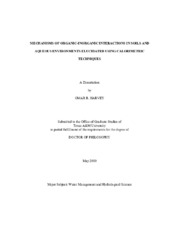| dc.description.abstract | Organic matter is ubiquitous in the environment and exists in many different forms. Reactions involving organic matter are diverse and many have significant economic and environmental implications. In this research, calorimetric techniques were used to study organic- inorganic reactions in two different systems. The primary objectives were to elucidate potential mechanism(s) by which: (i) natural organic matter (NOM) influences strength development in lime-stabilized soils, and; (ii) plant-derived biochars reacts with cations in aqueous environments.
Natural organic matter influenced strength development in lime-stabilized soils through the direct inhibition of the formation of pozzolanic reaction products. The degree of inhibition was dependent mainly on the type of pozzolanic reaction product, and the amount and source of organic matter. The formation of the pozzolanic reaction product, calcium silicate hydrate II (CSH2) was less affected by NOM, than was the formation of CSH1. For a given pozzolanic product, the inhibition increased with NOM content. The effect of organic matter source followed the order fulvic acid> humic acid> lignite. Formation of CSH pozzolanic reaction products decreased by 50-100%, 20-80% and 20-40% in the presence of ?2% fulvic acid, humic acid and lignite, respectively.
Cation interactions with plant-derived biochars were complex and depended both on the nature of the cation and biochar surface properties. Reactions involving the alkali cation, K+; occurred via electrostatic ion exchange, on deprotonated functional groups located on the biochar surface and; were exothermic with molar heats of reaction (?Hads) between -3 and -8 kJ mol-1. In contrast, reactions involving the transition metal cation, Cd2+ were endothermic with delta Hads between +10 and +30 kJ mol-1. Reaction mechanism(s) for Cd2+ varied from ion exchange/surface complexation in biochars formed at <350 oC, to an ion exchange/surface complexation/diffusion-controlled mechanism in biochars formed at >/=350 oC. For a given cation, differences in sorption characteristics were attributable to temperature-dependent or plant species dependent variations in the properties of the biochars. | en |


